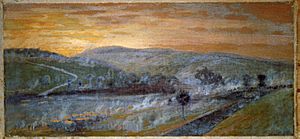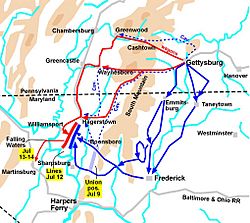Battle of Falling Waters facts for kids
The Battle of Falling Waters was a fight during the American Civil War. It happened from July 6 to July 16, 1863. People also called it the Battle of Williamsport or the Battle of Hagerstown. It was part of the Gettysburg Campaign. Neither side won a clear victory.
After losing at the Battle of Gettysburg, General Robert E. Lee's army started to retreat. They headed towards Hagerstown and Williamsport, Maryland. The Potomac River was flooded, so Lee's soldiers could not cross into Virginia. They set up a strong defense with their backs to the river. The Union army slowly followed Lee's forces. They arrived in the area around July 12. There were many small fights, and heavy fighting happened on July 13. That evening, the river's water level dropped. Lee's army then began crossing into Virginia. On July 14, Union cavalry attacked the Confederate rearguard. They captured about 700 soldiers.
Contents
Why Lee Invaded the North
By late 1862, Virginia was running out of food for its army. General Lee's horses were getting sick because they had little food. His cavalry and artillery units had to spread out to find food for their horses. In the winter of 1863, food trains from the south were becoming very rare. Lee's soldiers were living on tiny amounts of salted meat each day.
Confederate President Jefferson Davis wanted to send parts of Lee's army to other war fronts. But Lee did not agree. The Union Army of the Potomac had been very active. Lee felt he could not make his army any weaker.
In June 1863, Lee started his biggest plan of the war. He and his Army of Northern Virginia invaded the North for a second time. His first invasion ended at the Battle of Antietam in 1862. This time, he wanted to move the war out of Virginia. Virginia had been badly damaged by the war. Lee's army could no longer find enough food and supplies there. He also wanted to defeat the Army of the Potomac in the North. He hoped this would make the North give up and end the war. However, his army suffered huge losses at the Battle of Gettysburg.
Retreating from Gettysburg
On July 4, 1863, after three days of fighting at Gettysburg, both armies watched each other. The Union commander, General George G. Meade, sent out small groups of skirmishers. They were meant to check the Confederate lines. But Meade did not order a full attack. He knew it would be hard to force the Confederates out of their defensive spots.
Lee's main goal was to get his army and their captured supplies back to Virginia. He knew it was very risky to retreat when an enemy army was watching. Lee gave clear instructions on how the retreat would happen. The Confederate Army of Northern Virginia was to stay on Seminary Ridge all day on July 4. More than 10,000 wounded men would be moved by wagon train to Williamsport. From there, they would cross the Potomac River into Virginia.
Confederate General John D. Imboden's cavalry arrived at Gettysburg too late to fight. Because his unit was fresh, Lee gave Imboden a special job. He was to protect the wagon train of wounded soldiers on their way back to Virginia. On the afternoon of July 4, Imboden's 2,100 cavalrymen and 23 cannon left the battlefield. A heavy rainstorm helped hide their departure. They guarded the 17 miles (27 km) long train of wagons and ambulances. The roads were muddy, but they carried the wounded and food to Williamsport. Union cavalry attacked the wagon train several times during the trip.
When Imboden reached Williamsport on July 5, he found the Potomac River was flooded. It was too high to cross. The rest of Lee's army followed on the night of July 4-5. J.E.B. Stuart's Confederate cavalry kept them hidden. The next day, the Union army found out the Confederates had left. They then carefully followed them.
Waiting at Williamsport
General Imboden learned that 3,000 Union cavalry soldiers were coming. He quickly formed a half-circle defense around the town. He fought them off until nightfall. Then, another Confederate cavalry brigade arrived and drove the Union soldiers away.
By July 11, most of Lee's main army had reached Williamsport. Lee made the defenses stronger. He waited for the Potomac River to go down so his army could cross. General Meade's army reached Williamsport on July 12. They started testing the Confederate defenses. The Potomac River finally became low enough to cross on July 13. Confederate engineers had built a pontoon bridge about 4 miles (6.4 km) downstream at Falling Waters. At both Williamsport and Falling Waters, the Confederate army began crossing the river that evening.
The Fight at Falling Waters
The last of Lee's soldiers to cross the Potomac were his rearguard. This group had about 3,000 men. They were led by Major General Henry Heth. They marched all night and took their positions on a ridge behind Falling Waters.
On the morning of July 14, Meade was surprised. He learned that Lee had moved most of his army across the Potomac. Meade immediately ordered two companies of Michigan cavalry to attack. These soldiers were led by a newly promoted General George Armstrong Custer. The cavalry charged up the ridge to attack Heth's Confederates. But they were badly hit. Custer had his cavalry get off their horses and fight on foot.
At first, the Confederates did not lose many men. But during heavy fighting, Confederate General J. Johnston Pettigrew was badly wounded. He commanded a North Carolina brigade under Heth. More Union soldiers arrived. After over two hours of fighting, more than 500 Confederates were captured. Heth's men carried the wounded Pettigrew and crossed the river. This ended the battle. The Battle of Falling Waters was the last fight in the Gettysburg Campaign.
What Happened Next
Major General Hugh Judson Kilpatrick was Custer's commanding officer. He sent only two companies of cavalry against two brigades of Confederates at Falling Waters. This was a missed chance. He did not wait for more units to arrive. To hide his mistake, he claimed his division captured over 1,500 prisoners.
General Lee surprisingly spoke out against this claim in Northern newspapers. A reporter for the New York Times gave a different story. He wrote that the charge was very brave. He said a group of 57 men charged against three or four brigades behind earthworks. He claimed they killed one Major-General (Pettigrew) and captured over 1,000 prisoners.
Images for kids




